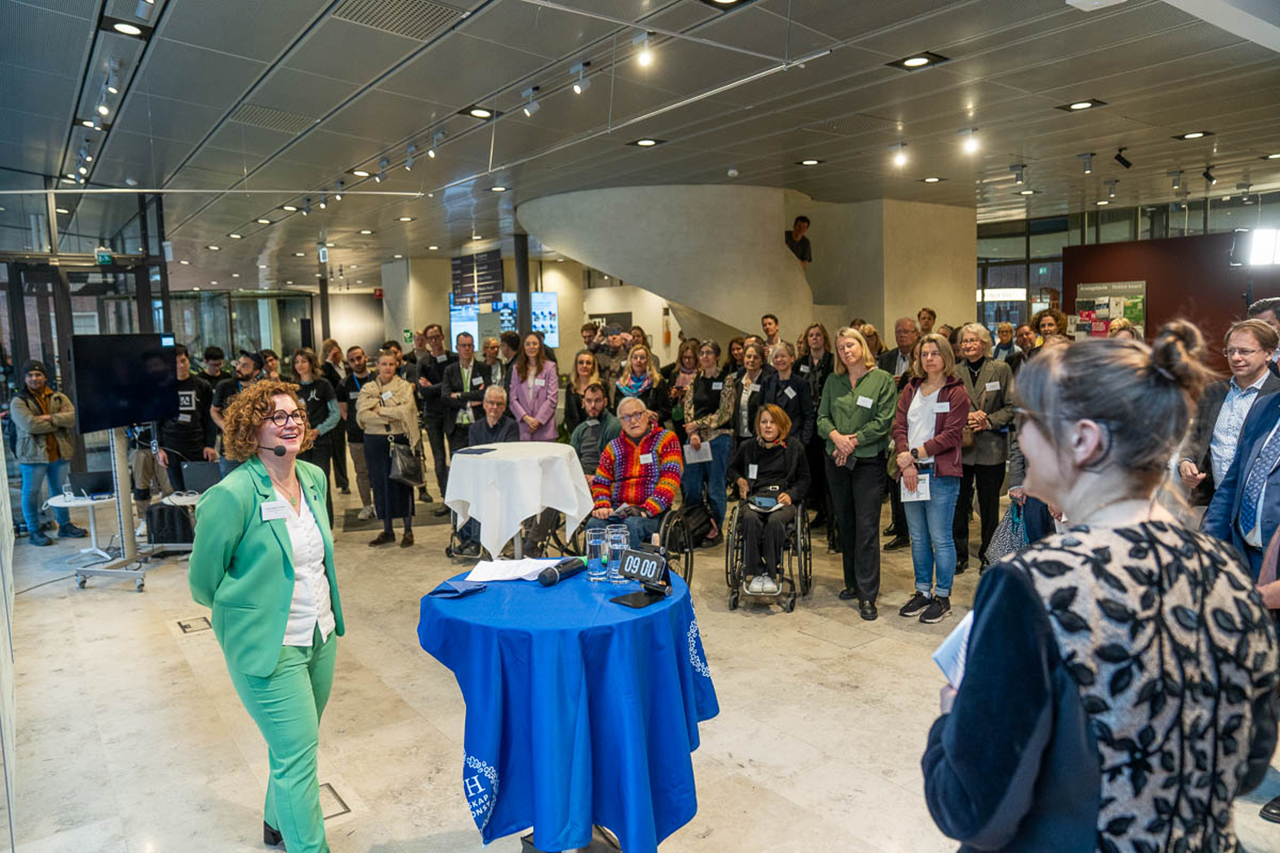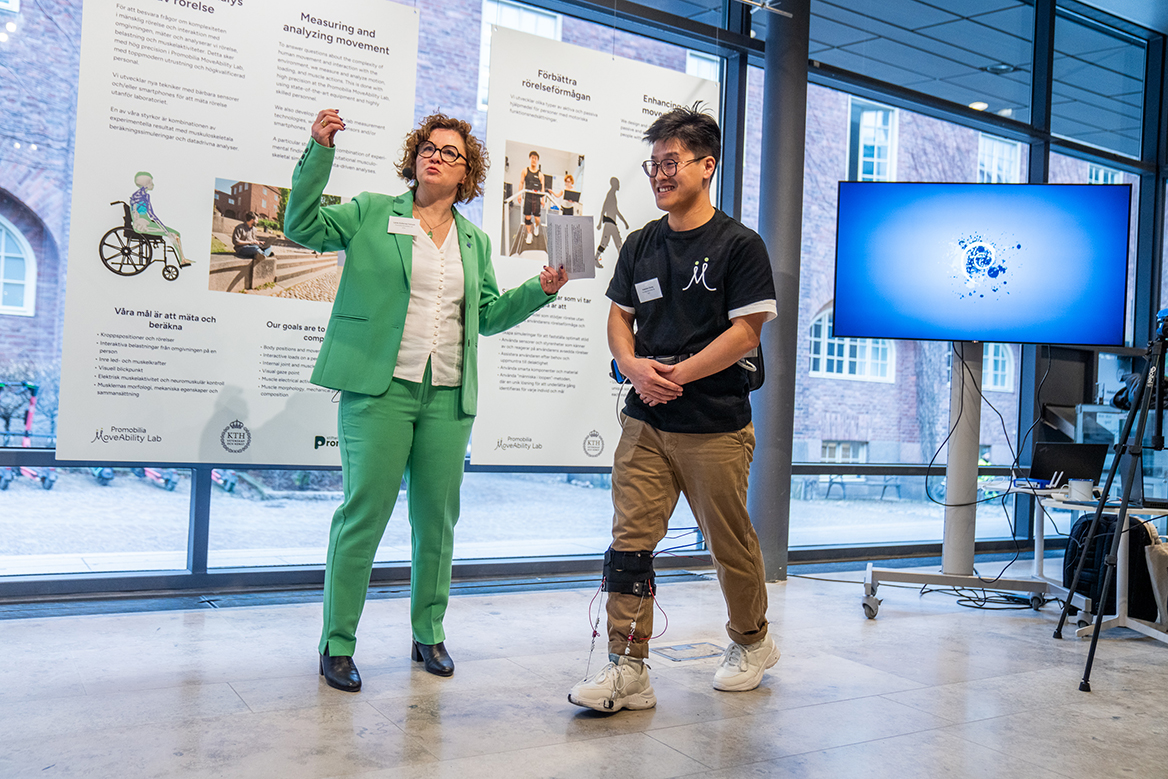Re-Inauguration of the Promobilia MoveAbility Lab

On Thursday 21 March, we held our big event to mark the new investment by the Promobilia Foundation and KTH and to strengthen our lab and our research. It was a packed, stimulating, and festive event.
As the approximately 90 guests gathered in the KTH Library, just across the street from our lab, breakfast was served, then the event began with an introductory speech by KTH President Anders Söderholm.
- The reason why there is now such a good focus on these issues that the lab works with is that motor disabilities affect just over five percent of the population. They can be congenital, acquired or come at an older age. "We know that the body is a complex machine with many interacting parts, and linking the body's functions with the technology that can help them perform better is part of what the lab does.
He also took the opportunity to express pride and joy in the collaboration with the Promobilia Foundation, whose large donation forms the basis for the renewed collaboration with KTH.
Then the Chairman of the Promobilia Foundation , Jan Bernard Waage, also known as JB, spoke about the initiative and why they are investing even more in research at KTH.
- For us, research is not an end in itself, but a means to an end. It should help those with disabilities to have a better life. So for us, the research must be useful, so that the research becomes something and that the results lead to new techniques, methods, and treatments. New gadgets, anything that leads to a better life for people living with disabilities. That's our goal and what we're looking forward to coming out of this collaboration.
JB also explained that the foundation plans to increase its donations to Swedish and international research from an already extensive level.
Eva Halén, business development coach at KTH Innovations, moderated the meeting. One question she asked Professor Lanie Gutierrez Farewik , research leader and director of the Promobilia MoveAbility Lab, was who benefits from the movement data collected by the lab, apart from the researchers themselves.
- "It could be the person, who needs inspiration for their training or rehabilitation. Then the clinicians benefit greatly from this, because they can get more information about where they should target their interventions. They can form a better idea of what is realistic to achieve in the individual case, regardless of whether it involves surgery, rehabilitation, training or aids.
It was then time for presentations on what the lab does: decoding human movement, measuring and analysing human movement, and developing active and passive devices to improve mobility. Lanie began by providing an insight into the complexities of motor behaviour:
- "When you walk or move, a lot of things happen that you don't think about. It is the brain that has determined a certain movement pattern and sends signals to the muscles. And the body senses the environment, the surface and any aids with the sensors we have built in, touch, sight and hearing. All this happens quite automatically. The brain adapts the body's movements to what is optimal in the situation at hand. But it is not crystal clear what is optimal. It may be that it is most energy-efficient to move in a certain way in a certain situation. Then you can tighten up, but the body's own way of moving is often about keeping calorie consumption down. When you are in pain, however, other things may apply. To relieve a sore knee, for example, you feel that you need to adjust your movement pattern. Then the movement is optimised for that purpose, not to save energy.
Docent
Ruoli Wang
, Deputy Director, explained the different measurement methods being developed in the lab. These include the use of different motion cameras and sensors when subjects move on treadmills and so on. But the researchers have also developed methods to measure movement outside the lab, in real-life situations, and which can even be used at home.
"Using ordinary cameras and simple visual codes, similar to QR codes, printed and applied to subjects, or even with a mobile phone, it may be possible to measure movement patterns, without having to measure in a movement lab. This is something that can be used for many reasons, such as convenience or to investigate movement patterns in real environments. The camera tracks the movements in real time and translates them into a model, in a very cost-effective way. It will then be possible to analyse the collected motion data."
In this part of the presentation, first postdoc Frederico Klein gave a demonstration using such QR codes and a webcam. Developer Panagiota Papadopoulou then showed how the lab is working on capturing movements with a regular iPad.
Lanie and PhD student Xiaochen Zhang demonstrated a solution for a so-called drop-foot gait pattern after a stroke, for example, where the patient has difficulty holding up the foot. The solution is an exoskeleton consisting of a sneaker with steel wires pulled in by motors worn around the waist. A major challenge is to get the right force in the cables and the right timing, so that the foot is optimally controlled for this particular patient, as people with drop foot gait can be very heterogeneous.

"An important challenge when developing assistive devices, in addition to providing the right support, is that they should get in the way as little as possible. Then they have to provide the right amount of support, because you want the patient to be involved in the movement", Lanie explained.
After the presentations, doctor and researcher Claes Hultling from the Spinalis Foundation gave a speech in which he praised the collaboration and the new initiative, which he said could be the start of a new era for research that helps people with mobility impairments. He also presented two Easter eggs, one to the Promobila Foundation and one to Lanie and her research team.
Lanie concluded by thanking everyone for coming and with that the formal part of the programme ended.
Participants were then invited to visit the lab across the street. There, they met PhD students Asta Kizyte and Ruoyu Huang, who presented research on measuring and analysing muscle activity and muscle tissue; PhD student Minh Truong presented research on different factors affecting walking performance in people with incomplete spinal cord injury; and PhD student Ibrahim Hasan explained plans to measure shoulder strain and overload in people with complete spinal cord injury who need a wheelchair. Also present were lab engineer Antea Destro, who gave a demonstration of motion measurement in three dimensions, and post-doctoral researcher Israel Luis, who described his work on an ankle exoskeleton with springs that reduce metabolic energy. PhD student Yuanyang Zhang showed an exoskeleton that can provide both assistance and resistance in the ankle, depending on the clinical goal.
All in all, there were great opportunities to see and hear what the Promobilia MoveAbility Lab is used for and to meet the researchers and experts who work intending to improve the lives of those living with mobility impairment.
